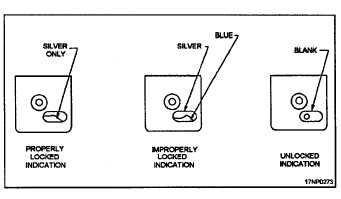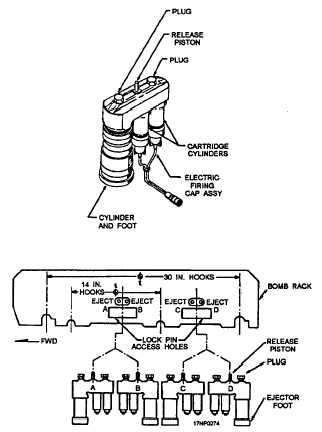Once the parts have been properly cleaned, you
should inspect them for damage or wear and replace or
repair the parts as necessary. Before reassembling the
ejector mechanism, apply a light coat of general-
purpose preservative lubricating oil (VV-L-800). To
prevent the piston from locking up, you must wipe off
all the excess oil.
For further information concerning the Aero 7A-5
and Aero 7B-4, refer to the publication Ejector Rack
Assembly Model Aero 7A-5, NAVAIR 11-5D-20.
BRU-10A/B AND BRU-11A/A BOMB
EJECTOR RACKS
The BRU-10A/B and BRU-11A/A bomb ejector
racks are used to mount and sway brace a single
weapon/store or for a variety of multiple weapon/store
adapters. The BRU-10A/B bomb ejector rack is pylon
mounted on the wing stations of the A-7E aircraft. It is
part of the aircraft’s basic weapon/store suspension
system. It may also be weapons-rail mounted to the
F-14 aircraft fuselage. The BRU-11A/A bomb ejector
rack is pylon mounted on the wing stations of the S-3
aircraft. It is part of the aircraft’s basic weapon/store
suspension system.
BRU-10A/B Bomb Ejector Rack
The BRU-10A/B bomb ejector rack (fig. 10-15) has
four suspension hooks-two hooks spaced 14 inches
apart and two hooks spaced 30 inches apart. It carries
weapons/stores weighing up to 4,000 pounds. The
bomb ejector rack has the necessary electrical
connections, mechanical and electrical arming units,
ejection components, and the mechanical linkage for
safely suspending and ejecting weapons or stores.
Although the BRU-10A/B bomb ejector rack differs
from the bomb ejector racks previously discussed, the
basic principles of operation are the same, except for the
operations discussed in the following paragraphs. As
you read them, refer to figure 10-15.
A manual cocking bolt and a manual release bolt are
located on the forward left-hand side of the frame
assembly, Before you load a weapon or store, manually
cock the mechanical linkage by rotating the cocking
bolt. This places the linkage sears in a position to lock
the suspension hooks when they are moved to the closed
position. The suspension hooks may be released
(opened) by manually rotating the manual release bolt.
To prevent damage to the mechanical linkage, you must
remove the safety flag assembly (safety pin) before you
rotate either the cocking bolt or the release bolt.
Figure 10-16.—BRU-10A/B bomb ejector rack hook latched
indicators.
To find out if the suspension hooks are properly
Iocked, you must visually check the latch inspection
holes (fig. 10-16) located in the frame assembly above
each hook. If the hook is properly locked, you can see
a silver latch indicator through the latching inspection
hole. If the hook is not locked, you can see a blue or
silver latch indicator. If the hooks are unlocked (open),
the latching inspection hole will be blank.
The BRU-10A/B bomb ejector rack is designed to
hold one ejector assembly that can be inserted in the
bomb rack in one of four different positions (fig. 10-17).
Figure 10-17.—BRU-10A/B bomb ejector rack ejector
assembly and installation positions.
10-13




